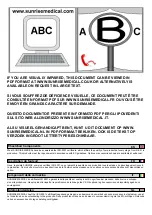
ENGLISH
14
Life R Rev.2.0
Occupant Restraints Instruction:
1. The pelvic restraint belt must be worn low across the front
of the pelvis so that the angle of the pelvic belt is within the
preferred zone of 30 to 75 degrees to the horizontal.
A steeper (greater) angle within the preferred zone is desirable
i.e. closer to, but never exceeding 75degrees. (Fig C)
2. The upper torso restraint belt must fit over the shoulder and
across the chest as illustrated Fig d and e
Restraint belts must be adjusted as tightly as possible
consistent with user comfort.
Restraint belt webbing must not be twisted when in use.
The upper torso restraint belt must fit over the shoulder and
across the shoulder as illustrated in Fig D and E.
3. The attachment points to the chair are the inner front side
frame just above the castor, and the rear side frame. The straps
are fitted around the side frames at the intersection of the
horizontal and vertical frame tubes. (See Figs G-H-I)
4. The tie down symbol (Fig F) on the wheelchair frame
indicates the position of the wheelchair restraint straps. The
straps are then tensioned after the front straps have been fitted
to secure the wheelchair.
Positioning of wheelchair tie down restraints on wheelchair:
1. Location of the front and rear tie down labels (Fig.G - H).
2. Side view diagram of tie down straps, (Fig.K).
Fig.D
Fig.E
Fig.C
PREFERED
ZONE
Fig.F
Transportability
Fig.H
Fig.G
Fig.I















































